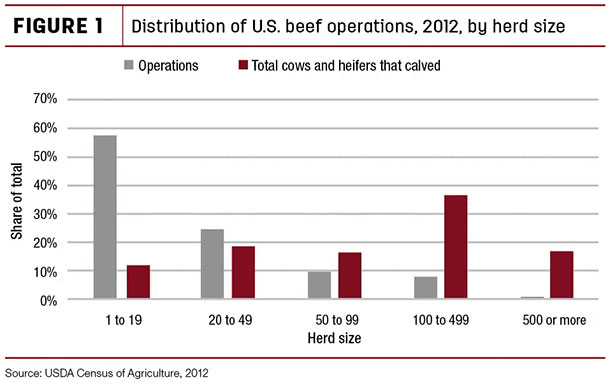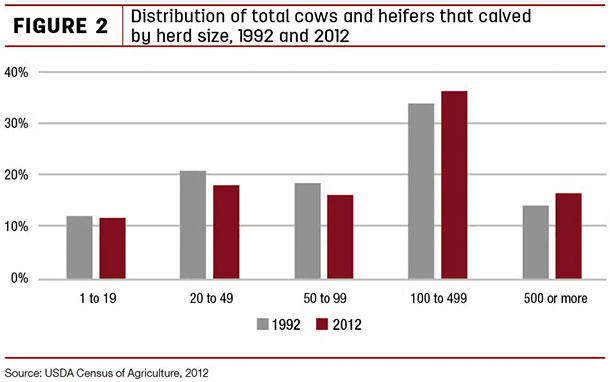With operations expanding, many wonder just “how large” farms and ranches have become.
To understand just how large, it’s helpful to look at the distribution of U.S. beef operations. To do this, USDA Census of Agriculture data was considered. Throughout this article, cows will be used to describe the USDA’s specific data category of cows and heifers that have calved.
Operations and cows
In Figure 1, the distribution of U.S. beef operations in 2012 is shown by two measures. The first is the number of operations by cow herd size, shown in orange. In 2012, 57 percent of beef operations had fewer than 20 cows.

The fact a majority of U.S. beef operations are small-scale probably comes as a surprise to many.
On the other end of the spectrum, fewer than 9 percent of beef operations in the U.S. have 100 or more cows in their herd.
The second measure for observing the distribution of U.S. beef operations is the total number of cows by cow herd size, shown in blue. While a majority of operations have fewer than 20 cows, these operations in total account for less than 12 percent of the U.S. cow herd.
The 9 percent of beef operations that have 100 or more cows collectively account for a majority of the U.S. cow herd (53 percent).
Concentration is most evident with operations having 500 or more beef cows. Collectively, these operations are less than 1 percent of all beef operations but account for 17 percent of all beef cows.
Historical perspective
While the distribution alone is interesting, it is helpful to consider how these data might have shifted in recent years. To do this, data from the 1992 Census of Agriculture were used.
At a high level, things have not changed too much over the 20 years of data. In 1992, there were an average of 42 beef cows per operation. In 2012, this stood at 41.
Digging deeper into the data shows a shift by herd size.
In Figure 2, the distribution of total cows by herd size is shown for 1992 and 2012. In general, smaller herd sizes accounted for a smaller share of total cows in 2012.

More specifically, those with fewer than 100 cows accounted for 47 percent of total cows in 2012, down from 52 percent in 1992.
On the other hand, the larger herd sizes have accounted for a larger share of total cows. Operations with 100 or more cows accounted for 48 percent of all cows in 1992, but accounted for 53 percent in 2012. The share of total cows of operations with more than 500 head increased from 14 percent in 1992 to 16 percent in 2012.
Wrapping it up
When looking at any industry, the distribution of production is typically insightful. For U.S. beef production, a majority of beef producers have fewer than 20 beef cows while a small number of large-scale producers (the 9 percent of total operations that have 100 or more cows) manage a majority (53 percent) of U.S. beef cows.
From 1992 to 2012, small shifts in the distribution of beef cows were observed. While the average head per operation was slightly lower, larger operations accounted for a larger share of total cows.
Operations with fewer than 100 cows accounted for a majority of cows in 1992 (52 percent), but this shifted by 2012 when operations with 100 or more cows represented the majority of U.S. beef cows (53 percent).
While the U.S. beef herd has shifted to larger operations, many would likely be surprised to realize these have been rather small changes for 20 years. Furthermore, many would also be surprised to learn a majority of beef operations have fewer than 10 head.
Looking ahead, the USDA will be conducting its 2017 Census of Agriculture early in 2018. The results of this census will be important for monitoring and tracking trends such as these. ![]()
David Widmar is an agricultural economist specializing in agricultural trends and producer decision-making. He is the co-founder of Agricultural Economic Insights LLC and a researcher in the Center for Commercial Agriculture at Purdue University. Follow David on twitter.

-
David Widmar
- Agricultural Economic Insights
- Email David Widmar








